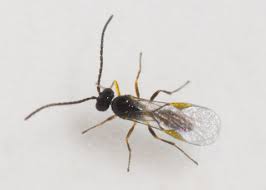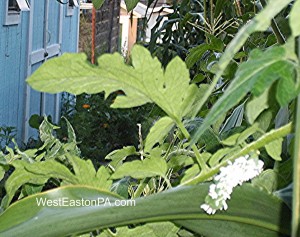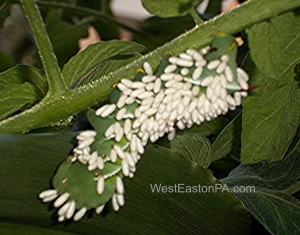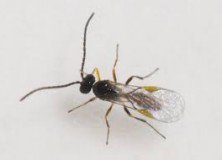
If you’re like me, we’re ardent fans of homegrown tomatoes. You prefer the taste of real tomatoes and not the greenhouse, or cardboard varieties the stores overcharge for.
Today, I found something that I had only read about and didn’t recognize it when I found it. I’d like to introduce my fellow gardeners to it. This way, you’ll know to let nature take its course and promote the population of beneficial insects that help destroy garden pests.
Meet the Braconidae, a wasp family that is a friend to the home gardener and commercial producer alike.Belonging to Hymenoptera, the same order as ants, bees and other wasps, these little jewels are a significant biological control against thousands of other insect species, including many that are considered pests.

Although highly variable in appearance, they are usually dark with four transparent wings and rarely over one-half inch long. Their size and the fact that there are over 15,000 described species make them difficult to notice, much less identify.
The quality that makes this insect family worth noticing is that most of them are parasitoids: parasites which usually kill their hosts. And, they like to feed on things we don’t like in our gardens: hornworms, caterpillars, beetles, aphids, squash bugs and stink bugs are among the many pests that members of the Braconidae family consider gourmet delicacies.
Different species attack their insect hosts during different stages of development, as eggs, larvae, pupae, or adults. They may become internal or external parasites. Braconid females can use the ovipositor, the tube through which eggs are laid, to sting. They generally don’t unless trapped or mishandled. The sting is considered medically harmless.

Individual species tend to be specialized to a particular host. A good example is the Cotesia congregatus (older name, Apanteles congregatus). Less than 1/8 inch long, black with yellowish legs and clear wings, this tiny wasp considers the tobacco hornworm (Manduca sexta) and the tomato hornworm (Manduca quinquemaculata) “meals on wheels.”
The female wasp uses her ovipositor to lay eggs just under the skin of an unlucky hornworm. As the eggs hatch, the larvae feed on the hornworm’s viscera–literally eating a hornworm alive. Larvae chew their way out through the host’s skin when they mature.
Once outside, the future wasps pupate, spinning tiny oval cocoons that look like insect eggs along the external back and sides of the worm. These fellows–and ladies–are not just innocently hitching a ride. When the adult wasps emerge from the cocoons, the already weakened hornworm will soon die, thus preventing any further defoliation on tomato plants.
So, if you see a bright green hornworm carrying what looks like a clutch of white-colored insect eggs on its back, leave it there! The hornworm is not only feeding its own destruction, it is also carrying potential destroyers of hornworm brothers, sisters and descendants. That means we get those wonderful, luscious tomatoes right off the vine, the braconids get a meal and a future, and the hornworms are destroyed without the use of pesticides.
Should you think that this caterpillar would have turned into a butterfly, relax. It would have become the large Hawk Moth.
Disclaimer: On January 4, 2016, the owner of WestEastonPA.com began serving on the West Easton Council following an election. Postings and all content found on this website are the opinions of Matthew A. Dees and may not necessarily represent the opinion of the governing body for The Borough of West Easton.







